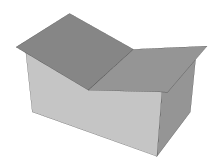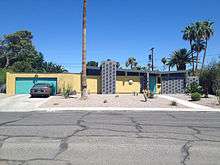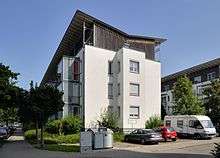Butterfly roof



A butterfly roof (sometimes called a V roof or London roof) is a form of roof characterised by an inversion of a standard roof form, with two roof surfaces sloping down from opposing edges to a valley near the middle of the roof.[1] It is so called because its shape resembles a butterfly's wings.[2] Butterfly roofs are associated with mid-century modern architecture. The form has no gutter as rainwater can run off the roof in no more than two locations - at either end of the valley, often into a scupper or downspout. The form may be symmetrical, with the valley located in the center, or asymmetrical with an off-center valley. The valley itself may be flat, with a central roof cricket diverting water towards the valley ends, or sloping if the entire roof form is tilted towards one end of the valley. The roof also allows for higher perimeter walls with clerestory windows allowing light penetration without impacting privacy.[3]
History
The butterfly roof is commonly credited to be the creation of William Krisel and Dan Palmer in the late 1950s in Palm Springs, California. It has been estimated that starting in 1957, they created nearly 2,000 houses in a series of developments that were popularly known as the Alexander Tract, which has been described by historian Alan Hess as "the largest Modernist housing subdivision in the United States."[2] Krisel confirms while his work popularized the form, he was not its originator.[2] The timeline of the emergence of the butterfly roof:[3]
- 1930: Le Corbusier, the Swiss-French architect, first used the butterfly roof form in his design of Maison Errazuriz, a vacation house in Chile.
- 1933: Antonin Raymond, the Czech-born architect, used this form on a house in Japan, whose design was featured in Architectural Record in 1934.
- 1945: Marcel Breuer used this form on his Geller House project in Long Island, New York, USA.
- 1957: Krisel's first use of the form in Twin Palms neighborhood of Palm Springs, California, USA.
References
- ↑ The Free Dictionary definition. Retrieved 2016-04-09
- 1 2 3 Palm Springs Modernism - The Butterfly Effect, Morris Newman in Palm Springs Life, February 2009. Retrieved 2016-04-09
- 1 2 Le Corbusier's Forgotten Design: SoCal's Iconic Butterfly Roof, Marni Epstein-M3rvis in Curbed, December 22, 2014. Retrieved 2016-04-09